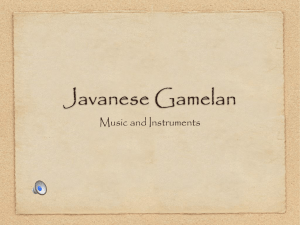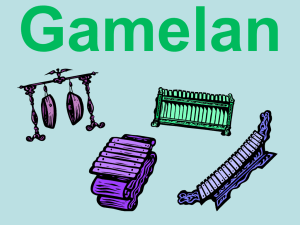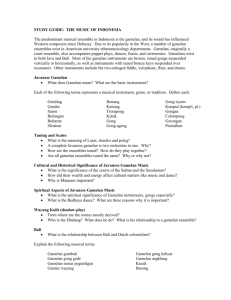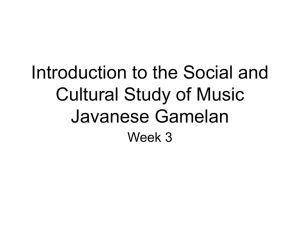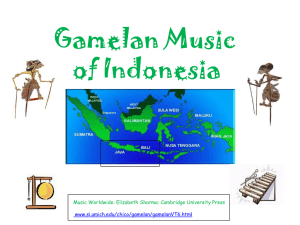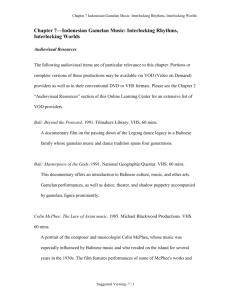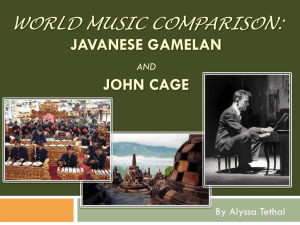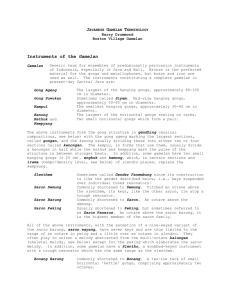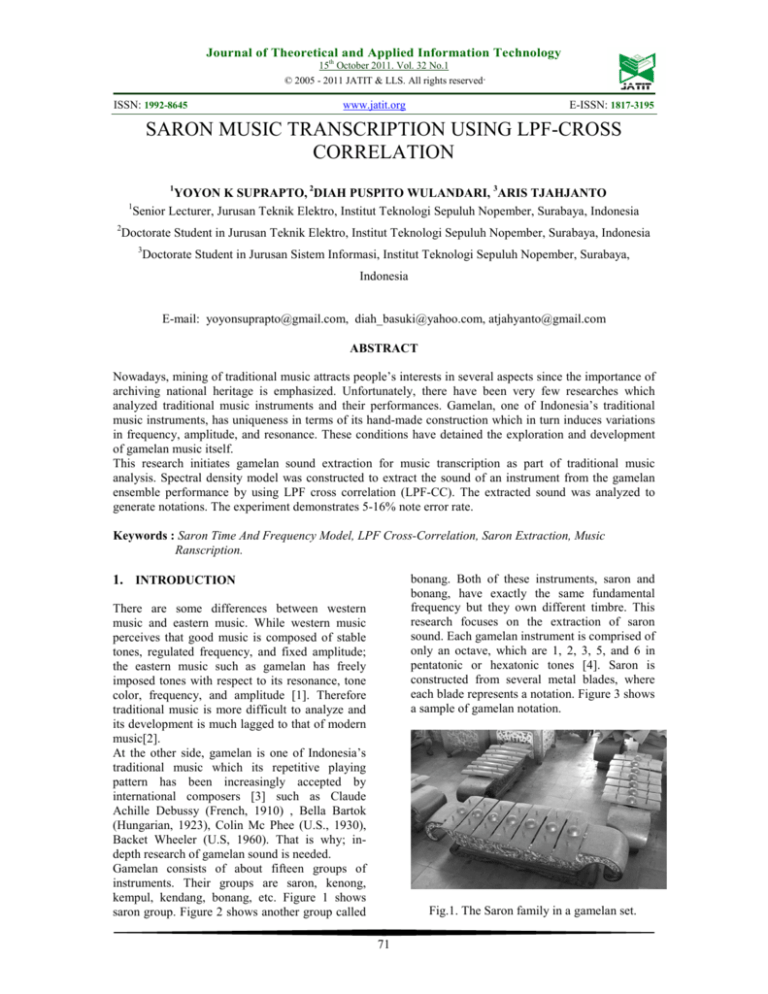
Journal of Theoretical and Applied Information Technology
15th October 2011. Vol. 32 No.1
© 2005 - 2011 JATIT & LLS. All rights reserved.
ISSN: 1992-8645
www.jatit.org
E-ISSN: 1817-3195
SARON MUSIC TRANSCRIPTION USING LPF-CROSS
CORRELATION
1
1
2
YOYON K SUPRAPTO, 2DIAH PUSPITO WULANDARI, 3ARIS TJAHJANTO
Senior Lecturer, Jurusan Teknik Elektro, Institut Teknologi Sepuluh Nopember, Surabaya, Indonesia
Doctorate Student in Jurusan Teknik Elektro, Institut Teknologi Sepuluh Nopember, Surabaya, Indonesia
3
Doctorate Student in Jurusan Sistem Informasi, Institut Teknologi Sepuluh Nopember, Surabaya,
Indonesia
E-mail: yoyonsuprapto@gmail.com, diah_basuki@yahoo.com, atjahyanto@gmail.com
ABSTRACT
Nowadays, mining of traditional music attracts people’s interests in several aspects since the importance of
archiving national heritage is emphasized. Unfortunately, there have been very few researches which
analyzed traditional music instruments and their performances. Gamelan, one of Indonesia’s traditional
music instruments, has uniqueness in terms of its hand-made construction which in turn induces variations
in frequency, amplitude, and resonance. These conditions have detained the exploration and development
of gamelan music itself.
This research initiates gamelan sound extraction for music transcription as part of traditional music
analysis. Spectral density model was constructed to extract the sound of an instrument from the gamelan
ensemble performance by using LPF cross correlation (LPF-CC). The extracted sound was analyzed to
generate notations. The experiment demonstrates 5-16% note error rate.
Keywords : Saron Time And Frequency Model, LPF Cross-Correlation, Saron Extraction, Music
Ranscription.
bonang. Both of these instruments, saron and
bonang, have exactly the same fundamental
frequency but they own different timbre. This
research focuses on the extraction of saron
sound. Each gamelan instrument is comprised of
only an octave, which are 1, 2, 3, 5, and 6 in
pentatonic or hexatonic tones [4]. Saron is
constructed from several metal blades, where
each blade represents a notation. Figure 3 shows
a sample of gamelan notation.
1. INTRODUCTION
There are some differences between western
music and eastern music. While western music
perceives that good music is composed of stable
tones, regulated frequency, and fixed amplitude;
the eastern music such as gamelan has freely
imposed tones with respect to its resonance, tone
color, frequency, and amplitude [1]. Therefore
traditional music is more difficult to analyze and
its development is much lagged to that of modern
music[2].
At the other side, gamelan is one of Indonesia’s
traditional music which its repetitive playing
pattern has been increasingly accepted by
international composers [3] such as Claude
Achille Debussy (French, 1910) , Bella Bartok
(Hungarian, 1923), Colin Mc Phee (U.S., 1930),
Backet Wheeler (U.S, 1960). That is why; indepth research of gamelan sound is needed.
Gamelan consists of about fifteen groups of
instruments. Their groups are saron, kenong,
kempul, kendang, bonang, etc. Figure 1 shows
saron group. Figure 2 shows another group called
Fig.1. The Saron family in a gamelan set.
71
Journal of Theoretical and Applied Information Technology
15th October 2011. Vol. 32 No.1
© 2005 - 2011 JATIT & LLS. All rights reserved.
ISSN: 1992-8645
www.jatit.org
E-ISSN: 1817-3195
Table 1 Saron fundamental frequency from
several gamelan sets.
Gamelan
Notation
Gamelan Fundamental Frequency
(Hz)
Set Set Set Set
1
2
3
4
Min Max
1
528
528
504
539
504
539
2
610
610
574
610
574
610
3
703
703
688
703
688
703
5
797
792
792
799
792
799
6
915
922
926
926
915
926
Fig 2 Bonang group in a gamelan set.
Music transcription of audio data is the process
of taking a sequence of digital data
corresponding to the sound waveform and
extracting from it the symbolic information
related to the high-level musical structures that
might be seen on a score [5]. For music
performance
which
comprises
several
instruments, like the one in an orchestra, the
sound of specific instrument needs to be
extracted first before generating the notations,
because each instrument may be guided by
different notations. Many algorithms have been
applied to extract an instrument sound. Most of
them use Short-time Fourier Transform (STFT).
Barbancho et. al. used STFT and sliding
windows to determine the onset and time
duration of a notation’s signal [6][7] shifted
slightly the threshold to determine fundamental
frequency [8]. Extraction was carried out based
on fundamental frequency and its power
density. J. P. Bello et. al. reported in their paper
that for synthesis process, they used harmonic
combs of estimated notes to isolate the relevant
signal components. They also created a database
of an instrument sound for diverse frequencies
and filled the gaps of the database by
synthesizing an instrument sound for particular
fundamental frequencies. In normalization
process, STFT was used by Barbancho, McNab,
and Witten to obtain the fundamental frequency
of a notation as well as to acquire Saron timefrequency characteristics. Previous researchers
(Barbancho, McNab, Bello) mostly analyzed
MIDI music that resulted from fabricated music
instruments, which is well tuned and has
uniform notation signal envelopes.
The target of this paper is to analyze the
acoustic music such as gamelan music. The
complexity of the playing style as well as the
hand-made construction of gamelan causes the
Lancaran Manyar Sewu
Buka : . 1 . 6 . 1 . 6 . 5 . (3)
. 5 . 3N
. 6 . 5N
. 3 . 2N
. 1 . 6N
. 5P . 3N
. 6P . 5N
. 3P . 2N
. 1P . 6N
. 5P . 3N
. 6P . 5N
. 3P . 2N
. 1P . 6N
. 6 P . [5]
. 3 P . [2]
. 1 P . [6]
. 5 P . (3)
Fig.3 Sample of gamelan notation
Figure 3 shows the notation of Manyar sewu
song. Gamelan music notation is not the same as
the western musical notation. Gamelan musical
notation is very simple. It consists of only 1, 2, 3,
4. 5, 6 and 7. This notation used by saron family
such as saron, demung and peking by strking each
written note once. Notes with superscript N (XN)
are stroke by kenong instrument while those with
superscript P (XP) are stroke by kempul
instrument. Notes inside brackets (X) must be
played by Gong Ageng instrument and those
inside square brackets [X] must be played by
Gong Suwuk instrument. So the notation of saron
leads the notation for other instruments as well.
Gamelan is manually constructed by hand.
Constructors tune the instruments with their own
sense, based on experience. As a result,
fluctuation of frequency inside the signal is not
set correctly. Saron is played by striking the
blade, so that its sound is basically impulsive [4].
The fundamental frequency of one gamelan
performance could be slightly different from one
gamelan to the other gamelan. Table 1 shows
saron fundamental frequencies from several
gamelan sets. Each note had varying frequency
range. The other octave is belonged by the other
instrument.
72
Journal of Theoretical and Applied Information Technology
15th October 2011. Vol. 32 No.1
© 2005 - 2011 JATIT & LLS. All rights reserved.
ISSN: 1992-8645
www.jatit.org
E-ISSN: 1817-3195
conventional music transcription to be hardly
adopted. In this paper, the model of spectral
density was build to produce estimated saron
sounds. These sounds were used as reference in
extraction process using LPF cross correlation
(LPF-CC), to generate estimated saron
waveforms. The music transcription was
established based on the extracted sounds. Saron
was chosen as the target group of gamelan sound
extraction due to the use of saron notation as the
basic notation for the other instruments.
2. CONVENTIONAL METHOD
Previous works in music transcription mostly
used STFT to extract the sound of particular
instrument in MIDI music performance. We
modified the STFT to apply it for acoustic music
performance. This modified STFT was used in
sound extraction process as a comparison with our
proposed method, LPF-CC. Finally, both methods
were evaluated by using the same data, gamelan
music performance.
Music transcription using STFT: Other
researchers applied non-overlapped STFT to
analyze MIDI music. We modified STFT into an
overlapped one because we tackle an acoustic
music where there may occur variations in the
sound signals, which might be influenced by
external factors such as hammer stroke strengths
and hammer stroke styles. Overlapped STFT
apparently eliminated the wild peaks of
magnitude in notation signal. This modification
then only considered the fundamental frequency
of the signal, while the harmonic and nonharmonic components were not addressed. Firstly
we determined the window length and the hop
length.
Fig. 4 Sound Extraction Based on Spectral
Density Model using LPF Cross Correlation.
The actual gamelan sounds x were yielded by
striking the instrument with a hammer which
was guided by the original gamelan notations
or. Signal x was then compared to the reference
signal y using cross correlation to form the cross
spectrum density [9][10]. Estimated notes were
obtained from fundamental frequency of each
musical note and were evaluated using note
error rate (ner) [11][12]. Ner was resulted from
note insertion, note substitution, and note
deletion. Gamelan simulated sounds were
produced by pitch-shifting method based on
phase-vocoder theory [13]. Figure 5 describes
simulated saron sound building using pitchshifted.
3. PROPOSED METHOD
LPF-CC is an advanced cross-correlation
algorithm that utilizes various window lengths
and is a pitch-shifting method which is used to
reduce the errors associated with conventional
music transcription. In this paper the spectral
density model of saron sound was built and then
compared to the real recorded gamelan
performance by using LPF-CC, in order to extract
the specific saron sound among the other
instrument’s sound. The LPF-CC algorithm is
described in Figure 4.
Fig. 5 The algorithm of simulated saron sound
building using pitch-shifted
73
Journal of Theoretical and Applied Information Technology
15th October 2011. Vol. 32 No.1
© 2005 - 2011 JATIT & LLS. All rights reserved.
ISSN: 1992-8645
www.jatit.org
In order to build the Saron time frequency
model, we applied 450 pre-recorded sounds of
saron instrument which consisted of several
combinations of hammer stroke strength and
hammer stroke areas. The pre recorded Saron6
sound, the sixth note of saron instrument, was
selected to be the standard tone for
normalization [4].
2.1 Saron time-frequency model based on the
spectral density
To analyze gamelan performance, simulated saron
sounds are important for sound extraction. To
construct the simulated saron sound, we need a
saron time frequency model. The model was
constructed from several single strokes of saron
sounds, called saron pre-recorded sounds. The
sounds are converted to Saron time-frequency
domain using STFT. The process continues by
registering the pre-recorded sounds as training
data. Each label of pre-recorded sound contains
notation name, instrument number, pre-recorded
sound number, b, and its fundamental frequency
estimation.
Before we discuss the STFT, we evaluate how to
convert time domain signal x(n) to frequency
domain X(f) using discrete Fourier transform
(DFT) which is described in Eq.(1),
In our previous research [14], we evaluated the
relationship of fundamental frequencies among
gamelan notes. The slendro gamelan scale, used
in the Javanese gamelan, has five equallytempered pitches. A musical equal temperament
is most simply described as a mathematical
series at Eq. (4),
Fm = 2
=
∑x e
n =0
− i 2πf / f s
n
n
N
(1)
where f is frequency, fs is sampling frequency, n is
time index, N is total sampling.
Due to gamelan characteristics, the estimated
fundamental frequency of each of gamelan notes
may vary. See table 1. The real fundamental
frequency of each pre-recorded sound is
determined by the maximum argument of the
absolute value of the spectrum as described in
Eq.(2),
max( f 0 ( c ))
where f0b is the fundamental frequency of prerecorded sound, c is blade number which
represents a note number, b is pre-recorded sound
number. Maximum argument is the set of values
of f for which X(f,b) has the largest value. f is
located between the minimum min(f0(c)) and
maximum max(f0(c)) value of fundamental
frequency in each notation c.
Normalized power density, XNb , can be obtained
by absolute Xb(f) divided by max(|Xb(f0b)|) which
is described in Eq.(3),
max( X ( f 0b ) )
Fr
(4)
Fm
)
Fr
(5)
Likewise, if we know a note Fr and the number
∆c of cents in the interval from Fm to Fr, then Fm
may be calculated Eq.(6),
f = min( f 0 ( c ))
Xb( f )
k
∆c = 1200 log 2 (
f 0b = arg max ( X ( f , b) ) + min(c) (2)
X Nb ( f ) =
m
where F is the fundamental frequency of a
musical tone, k is a positive integer constant, m
is an integer variable. k is equal to 5 for slendro
gamelan scale. The cent is a logarithmic unit of
measure used for musical intervals. 1200 cents
are equal to one octave — a frequency ratio of
2:1. If we know the frequencies Fm and Fr of
two notes, the number of cents measuring the
interval from Fm to Fr may be calculated by the
following formula Eq. (5),
X ( f ) = F [ x(n)]
N −1
E-ISSN: 1817-3195
Fm = 2
∆c
1200
Fr
(6)
The Saron time-frequency model is made based
on the pitch-shifting algorithm described in Fig.
5. Firstly, all fundamental frequencies of prerecorded sounds are shifted to the Saron6
fundamental frequency. The pitch shifting ∆f06
could be calculated using Eq.(7), where f0b is the
fundamental frequency of a pre-recorded sound
and f06 is the fundamental frequency of ideal
Saron6. Based on the pitch shift ∆f0s, all
frequency components were shifted by same ∆f0
and the shifted signal should be added by ∆fb
zero padding. Note that the fundamental
(3)
where N is total pre-recorded sound number.
74
Journal of Theoretical and Applied Information Technology
15th October 2011. Vol. 32 No.1
© 2005 - 2011 JATIT & LLS. All rights reserved.
ISSN: 1992-8645
www.jatit.org
E-ISSN: 1817-3195
frequency of ideal Saron6 f06 was obtained from
the average of the sixth notation’s fundamental
frequency of saron instrument from several
gamelan sets.
∆f b = f 0b − f 06
(7)
where b is pre-recorded sound number and f0b is
fundamental frequency of pre-recorded sound b
and f06 is the fundamental frequency of Saron6.
Figure 6 illustrates the spectral of pre-recorded
sound shifted to Saron6.
Fig. 7 Saron Time-frequency model.
Saron time-frequency model is used to construct
the simulated saron sound. Each model
produces a simulated saron sound. The other
models are obtained by shifting the fundamental
frequency to a specific frequency. The total
number of models is F unit. This means that
there will have F saron simulated sounds which
each has a fundamental frequency of 1 to F Hz.
All simulated saron sounds will form a database
in the process of cross correlation. The
simulated saron sound, template, can be
generated using Eq.(10).
Fig.6 Pre-recorded pitch shifting to the referenced
sound "Saron6"
The non-harmonic and harmonic components of
pre-recorded sound spectrum are shifted by ∆f
which is shown in Eq.(8),
^
X Nb ( f ) = X Nb ( f + ∆f )
^
x (k , f 0 ) =
(8)
^
F
∑ cos(2π ( f
∆f = − f +1
0
+ ∆f )t / f s )
A( k , f 0 + ∆ f )
where X Nb ( f ) is normalized shifted magnitude
of pre-recorded b.
The Saron time-frequency model can be
generated by adding k as time index parameter,
which is equivalent with the fixed window’s
length. The Saron time frequency model A(k,f) is
determined by averaging the power density
f0= 1,2,3 … F Hz
(10)
2.2 Saron sound extraction for
transcription using template
music
^
^
x (k , f 0 ) was
X Nb ( f ) of each frequency index of all pre-
The simulated saron sound
recorded sounds as shown in Eq. (5).
applied as a reference signal on the crosscorrelation process to form the cross power
spectrum which would generate saron
estimation waveforms. Figure 8 illustrates the
estimation process of saron transcription. Actual
gamelan waveform is generated by striking
gamelan instrument using original gamelan
note. Estimated saron waveform is extracted by
comparing the template to the actual gamelan
sound waveform using LPF cross-correlation,
which can be calculated using Eq.(11).
S
A(k , f ) =
∑X
b =1
^
Nb
S
(f)
(9)
where S is total number of pre-recorded sounds.
Figure 7 shows the Saron time-frequency model
of saron.
75
Journal of Theoretical and Applied Information Technology
15th October 2011. Vol. 32 No.1
© 2005 - 2011 JATIT & LLS. All rights reserved.
ISSN: 1992-8645
www.jatit.org
E-ISSN: 1817-3195
number, the magnitude of cross power density,
the offset and the onset.
All note candidates are sorted by the onset.
When there are more than one note candidates
which occur at the same time, the real note is
determined by choosing the one with highest
magnitude of power density.
Gamelan sound signal is influenced by many
external factors such as hammer stroke styles
and stroke strength, so it has various sound
qualities [15]. Figure 9 shows the spectrum of
gamelan sound which varies very much due to
the hardness and the style of stroke although it
still has the same fundamental frequency. This
figure shows a fundamental frequency of 2000
Hz. The harder stroke resulted in the emergence
of harmonic sound which has lower frequency
than that of gamelan sound signal. The length of
harmonic sound is also much shorter compared
with the fundamental frequency.
Fig.8 Estimated saron note generating
r ( k , n, f ) =
^
1 J −1
x (k , m + n) x ( m, f ) (11)
∑
J m =0
where n is lag, k is sampling index and J is the
^
length of the x and x . If f is frequency scanning
from 1 to F Hz, r(n,f) becomes cross spectral
density of observed signal x. The cross correlation
results in separated saron sound among the other
instrument sounds, which then be recognized as
estimated saron waveforms. Equation (12) shows
that by setting the value of f to be in particular
interval min(f0(c)) ≤ f ≤ max(f0(c)) we obtain the
occurrences of estimated saron waveforms which
are note candidates across time. The next step is
to translate the waveforms into candidate
notations.
Fig.9 The difference spectrum of the signal due
to differences in hammer stroke strength
Moreover, the sound of an instrument in
gamelan ensemble is always interfered by those
of other instruments. For example, the extracted
saron sound may still contain bonang sound
since both instruments have the same
fundamental frequency. In fact, the length of
bonang sound has shorter compared to that of
saron. While the length of saron sound has 500
ms, the length of bonang sound only has 150
ms. Figure 10 shows several estimated saron
waveform with various window’s length. The
presence of bonang sound appears as small
pulses inside the extracted saron sound for 40
ms of window’s length.
max( c )
p (k , c) = max ( r (k , n, f ) )
f = min( c )
(12)
where c = 1, 2, 3, 5, 6 is each gamelan note, and p
are estimated saron waveforms. It is necessary to
eliminate the noises occur in notation waveform
using threshold. In real gamelan performance,
each note may have different magnitudes due to
the difference of stroke strength during playing.
That is why different thresholds can be applied to
separate the real note-onset from noises. The
simplest way to segment notes is to set a
threshold to be 20 % of the maximum magnitude.
This value is arrived through experiments.
The candidate of note can be obtained by
determining the peaks occur in each estimated
saron waveform. Each note candidate has its note
76
Journal of Theoretical and Applied Information Technology
15th October 2011. Vol. 32 No.1
© 2005 - 2011 JATIT & LLS. All rights reserved.
ISSN: 1992-8645
www.jatit.org
E-ISSN: 1817-3195
Fig. 12 Bandpass filter parameters
Smoother waveform in notation signal will
increase the accuracy of music transcription
because it will minimize errors of transcription
related to the presence of pulses inside the
signal.
Fig. 10 Estimated Saron waveforms due to
various window’s length, J
The harmonic sound which is caused by the
interference of another instrument in gamelan
ensemble can be eliminated in two ways. First,
the presence of pulses can be suppressed by
altering the window‘s length. Larger window
makes the power density of bonang sound to be
much smaller than that of saron sound. The
second way is the use of low-pass filter to
suppress any ripples or pulses inside saron sound.
Figure 11 shows how an LPF (with different
values of the window’s length J) deprived pulses
inside saron’s notation signal.
3. PERFORMANCE EVALUATION
3.1 The Gamelan Songs for Testing
We generated two types of gamelan sound for
testing [17]:
1. Synthetic. Each gamelan note was
recorded and the ensemble was played
using computer with gamelan note
direction.
2. Full acoustic. Gamelan ensemble was
played by the players and was
recorded. We played two songs, song1
and song2. Both songs were recordings
of gamelan ensemble performances
which were consisted of nine
simultaneously played instruments.
Song1 was 110 seconds and song2 was
90 seconds of duration. Song1
contained 161 original notes, and
song2 contained 129 original notes.
3.2 Gamelan Transcription:
Fig. 11 Estimated Saron waveform after using
Low Pass Filter (LPF)
In order to show the effectiveness of template
matching for gamelan transcription, various
types of playing, such as single synthetic
gamelan, mixture of three synthetic gamelan
and gamelan ensemble were investigated. To
evaluate the estimated generated notes, we used
the note error rate [11][12]. Recognition of error
rates is stated by Eq.(13),
Since the frequency distance between successive
notes in saron instrument is only about 100 Hz, an
LPF with sharp transition is needed. The Kaiser
window was chosen to create a low pass filter,
because it generates the smallest number of filter
orders to obtain a sharp low pass filter [16].
Several parameters in the low pass filter including
the the passband (Fpass), and the stopband
(Fstop). See fig. 12.
77
Journal of Theoretical and Applied Information Technology
15th October 2011. Vol. 32 No.1
© 2005 - 2011 JATIT & LLS. All rights reserved.
ISSN: 1992-8645
ner =
www.jatit.org
deletion + insertion + substitution
totaltruesentence
4. CONCLUSION
In order to construct a robust instrument
extraction from music ensemble, a smoother
Saron time-frequency model and a template
matching scheme were proposed. According to
the performance test, the proposed method
provides 2 - 4% improvement from the
conventional method. This result shows the
effectiveness of template matching for picking
up specified instrument for music transcription.
The proposed method can also be applied to
other acoustic instruments apart from gamelan.
(13)
For evaluating the performance, gamelan
orchestra was investigated to show the
effectiveness of template matching for music
notation. The conventional methods STFT,
Barbancho, Rodger, Bello, were investigated with
our test data. For the smallest ner we did STFT by
using varying window’s length and a fix hop
length [18]. Figure 13 shows that by the
window’s length of 8192 samplings and hop
length of 2048 sampling, the performance
produced the smallest note error rate (ner). Using
overlap STFT, we obtained ner 9% for song1 and
18% for song2. LPF-CC generated ner 6% for
song1 and ner 16% for song2. LPF-CC and LPF
generated ner 5% for song1 and ner 14% for
song2. The overall results were then compared
with our proposed method Table 2 shows the
results as the ratio of ner.
REFRENCES:
[1] Sutton, Anderson, 1993. Central Javanese
gamelan music: dynamics of a steady state,
Northern Illinois University in DeKalb, Il.
[2] Olmo Cornelis, Micheline Lesaffre, Dirk
Moelants, Marc Leman,“ Access to ethnic
music: Advances and perspectives in
contentbased music information retrieval,”
Signal Processing 90 Elsevier, Amsterdam,
pp. 1008-1031, 2010
[3] Tamagawa K., 1998. Echoes from the east:
The Javanese gamelan and its influence on
the music of Claude Debussy, D.M.A.
document. The University of Texas at
Austin.
[4] Sumarsam, 1992, 1995. Cultural interaction
and musical development in central java,
The University of Chicago Press, ISBN 0226-78011-2.
[5] Eric Scheirer, 1995, “Extracting expressive
performance information from recorded
music,” Master’s thesis, MIT, 1995
[6] Barbancho, A. Jurado, 2004. Transcription
of piano recordings, Applied Acoustic 65
(12 SPEC. ISSN).
[7] Bello and M. B. Sandler, 2006. Automatic
piano transcription using frequency and
time-domain
information,
IEEE
Transaction on Audio, Speech and
Language Processing, vol. 14 no 6.
[8] Rodger J. McNab and I. H. Witten, 1996.
Signal processing for melody transcription,
Proceedings of the 19th Australian
Computer Science Conference, Melbourne,
Australia.3
[9] Pielemeier Willam J. and M. H. Simoni,
1996. Time-frequency analysis of musical
signals, Proceedings of The IEEE, vol.
Vol.84, No.9.
Fig.13 Note error rate ner against various
window’s length.
Table 2 Performance of saron extraction for
gamelan transcription by
conventional method STFT and LPF
cross-correlation (LPF-CC).
Instruments
8192
STFT
ACC
LPFCC
Synthetic
Total
Notations
30
1
2%
0%
0%
Synthetic
30
3
5%
3%
2%
Acoustic
sounds,
Song 1
Acoustic
sounds,
Song 2
161
9
9%
6%
5%
129
9
18%
16%
14%
Test Type
E-ISSN: 1817-3195
78
Journal of Theoretical and Applied Information Technology
15th October 2011. Vol. 32 No.1
© 2005 - 2011 JATIT & LLS. All rights reserved.
ISSN: 1992-8645
www.jatit.org
[10] David Havelock, Sonoko Kuwano, 2008.
Handbook of signal processing in acoustics,
Springer New York.
[11] Raphael C., 2002. Automatic transcription of
piano music, In Proc. ISMIR.
[12] Klapuri A P, 2003. Automatic transcription
of music, Proceedings of the Stockholm
Music Acoustics Conference, Sweden.
[13] Dolson, 1996. The phase vocoder: A tutorial,
Computer Music Journal, vol. Vol. 10, No.
4.
[14] Yoyon K Suprapto, Mochamad Hariadi,
Tsuyoshi Usagawa, 2009. Time frequency
modeling of gamelan instrument based on
time frequency for automatic notation, the
Third International Student Conference on
Advanced Science and Technology, Seoul,
Korea.
[15] Bokyung Sung, Jungsoo Kim, Jinman Kwun,
Junhyung Park, Jihye Ryeo, and Ilju Ko,
2009. Practical Method for Digital Music
Matching Robust to Various Sound
Qualities, World Academy of Science,
Engineering and Technology 60
[16] Oppenheim, RW Schaefer & J Buck, 1999,
Discrete Time-Signal Processing, 2nd ed.,
Prentice Hall.
[17] Bokyung Sung, Jungsoo Kim, Jinman Kwun,
Junhyung Park, Jihye Ryeo, and Ilju Ko,
“Practical Method for Digital Music
Matching Robust to Various Sound
Qualities,” World Academy of Science,
Engineering and Technology, 2009.
[18] Farshad Arvin, Shyamala Doraisamy, “RealTime Pitch Extraction of Acoustical Signals
Using Windowing Approach,” Australian
Journal of Basic and Applied Sciences, vol.
3(4), pp. 3557-3563, 2009.
E-ISSN: 1817-3195
AUTHOR PROFILES
Yoyon K Suprapto received
the bachelor degree in
Electrical Engineering from
Bandung
Institute
of
Technology,
Bandung,
Indonesia in 1977. He
received his Master of
Science Computer Science in
The University of Missouri,
Columbia, Missouri, USA in
1981, and Doctor degrees in in Electrical
Engineering Department of Institut Teknologi
Sepuluh Nopember (ITS), Surabaya, Indonesia,
in 2010 respectively. He joined Electrical
Engineering Department in Institut Teknologi
Sepuluh Nopember since 1977. His current
interests research area are Data Mining, Sound
Signal Processing and Traditional Music.
Diah Puspito Wulandari
received her bachelor
degree
in
electrical
engineering from Institut
Teknologi Bandung (ITB)
Indonesia and her master
degree
in
artificial
intelligence
from
University of Edinburgh United Kingdom in
2004 and 2006 respectively. She has been
attached as a lecturer in Department of
Electrical Engineering Institut Teknologi
Sepuluh Nopember Surabaya Indonesia since
2005 and she is now a doctoral student in the
same department. Her research interest focuses
in speech and audio signal processing.
Aris Tjahyanto received
the B.E. degree in
Electrical
Engineering
Department of Institut
Teknologi
Sepuluh
Nopember
(ITS),
Surabaya, Indonesia, in
1989. He received M.E.
degrees Computer Science
Universitas Indonesia in
1995. Currently, he is the staff of Information
Systems Deparment of Institut Teknologi
Sepuluh Nopember, Surabaya, Indonesia and he
is now a doctoral student in the same
department.. His research interest is in
Information Systems, Speech recognition and
Signal Processing.
79

